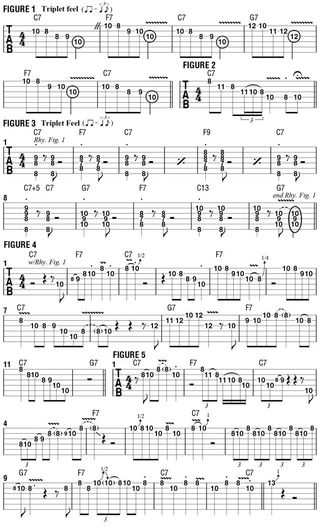Melodic Phrasing and Playing Over Blues Changes, Part 2

Last month, we took steps toward developing a deeper understanding of blues and how it informs both jazz and rock.
By practicing playing over standard blues changes with single-octave patterns, used as miniature “road maps,” we were able to incorporate the more colorful chord tones into melodic phrases and expand beyond the basic pentatonic shapes we all learn early on.
This month, we’ll begin with descending versions of such patterns. Previously, I had mentioned some famous examples of the “minor third into major third” melody. One of them was a great TV show theme I grew up hearing: Quincy Jones’ “Theme from Sanford & Son.”
The first bar of FIGURE 1 is a major pentatonic-based lick in the key of C that’s similar to this melody. It’s entirely descending, except for the ascending minor-to-major third (Eb to E). The remainder of FIGURE 1 moves the lick through the I, IV and V chords of a basic blues in C—C7, F7 and G7, respectively.
The intent here is to form a road map in order to establish a familiarity with the colorful notes, absorbing them as a source of vocabulary in practice, but not to force yourself to play them in live situations. They can also be blended with more standard minor pentatonic licks, as demonstrated in FIGURE 2.
FIGURE 3 is a blues vamp incorporating dominant seventh chords. Whereas the last lesson featured a slow “Red House”–style blues, this one is more of a mid-tempo swinging “Now’s The Time”/“Everyday I Have the Blues”–style groove. This figure features a “quick IV,” with a move to the IV chord, F7, in bar 2, followed by a return to the I chord, C7, in bars 3 and 4.
FIGURE 4 is an improvised solo played over these changes. The first lick is straight out of our previous lesson, an all-ascending pattern with the minor third into the major third. This is followed by the reverse, which follows the changes, just as described in FIGURE 1. The next few licks are in fact the ascending pattern with a few extra notes added, before reverting back to today’s descending pattern.
A brief critique of my own playing in the video example: The first 12-bar chorus feels rather forced. Normally, I would make it less obvious that these patterns are lurking behind my improvisations, but the purpose here is to demonstrate the examples. Fortunately, the second time around it lightens up a bit, as I begin to break away from the rigidity of sticking closely to one type of pattern, with a few minor pentatonic licks thrown in to add flavor.
Finally, in the third chorus, things begin to feel more natural. The patterns are still in the background as guides, but the playing is more open, allowing whatever comes to mind to happen. By gaining a better understanding of standard blues changes beyond the simplified rock vamps many of us learn early on—tools that can be both highly useful and severely limiting—we can strengthen our foundations as guitarists, no matter what styles we choose to play. Soon, we’ll expand beyond blues into chromaticism and other more complex tools to add to your improvisational palette.
Alex Skolnick photos from lesson video by Tom Couture | www.tomcouture.com

Get The Pick Newsletter
All the latest guitar news, interviews, lessons, reviews, deals and more, direct to your inbox!

Want to play Master of Puppets the right way? Here's how to get faster at downpicking so you can chug like James Hetfield
![Joe Bonamassa [left] wears a deep blue suit and polka-dotted shirt and plays his green refin Strat; the late Irish blues legend Rory Gallagher [right] screams and inflicts some punishment on his heavily worn number one Stratocaster.](https://cdn.mos.cms.futurecdn.net/cw28h7UBcTVfTLs7p7eiLe-840-80.jpg)
“The intensity of Rory’s guitar playing – the emotion, the sound and his incredible attack – was mindblowing for me”: Joe Bonamassa pays tribute to the late, great Irish blues-rock icon Rory Gallagher









